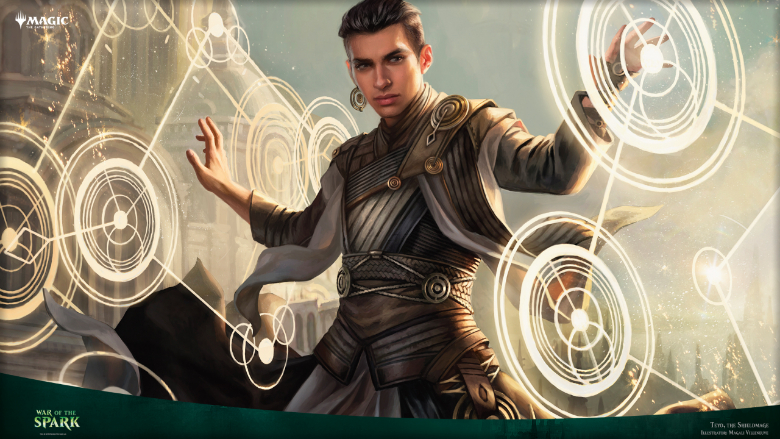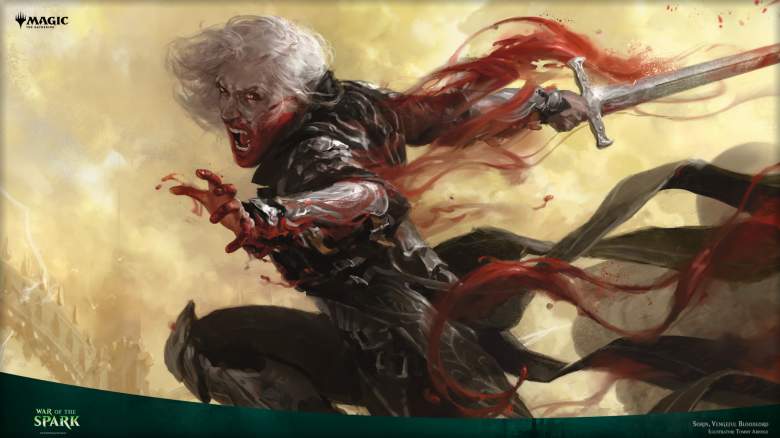
Oathbreakers is the latest Magic: The Gathering format to start picking up steam. In development by a group of players for some time, Oathbreaker is a multiplayer format that shakes up the typical Commander formula. The biggest change is instead of using a Legendary Creature as your general you will use any Planeswalker in the game’s long history. If you are looking for a new, eternal format to get into then Oathbreaker is certainly worth checking out.
Here’s a breakdown of all the information you need to get started in Oathbreaker.
1. Oathbreaker Rules

Oathbreaker is a multiplayer format where each player starts at 20 life and uses a 60 card, singleton deck. This means that you can not have any duplicate cards in your deck outside of basic lands. Of your 60 cards, 2 of them need to be your Oathbreaker (Planeswalker Commander) and that general’s Signature Spell.
You can use any Planeswalker except Saheeli, the Gifted as your Oathbreaker, but your deck will be restricted to their color identity. Any Planeswalker that is a creature that flips into a PLaneswalker cannot be your Oathbreaker. If you are using Domri Rade as your Oathbreaker then the cards in your deck and Signature Spell can only have the Green or Red mana symbol. Colorless cards can go into any deck, but they cannot have mana symbols that don’t appear on the card.
A Signature Spell is a unique Instant or Sorcery card that will sit in the command zone outside of the game with your Oathbreaker. You can only cast your Signature Spell if your Oathbreaker is on the field. Once it resolves, the spell will go back to the command zone. Every time you cast beyond the first costs an additional 2 colorless mana. So the second time you cast the Signature Spell it will cost 2 extra mana and the third time will require 4 extra mana.
Any card that uses the word “Commander” in the text will refer to Oathbreaker. (Example: Commander Tower taps for any color in your Commander (Oathbreaker’s) color identity.)
2. Oathbreaker Ban List

Just like other formats, Oathbreaker has its own ban list that is constantly updated as new cards are introduced. Unlike Commander, Oathbreaker has some pretty notable and staple cards banned due to their sheer power. These include Sol Ring, Doomsday, High Tide, Tooth and Nail, and Ad Nauseum. Additionally, any silver bordered cards are strictly banned, so don’t expect to see anything from the Unglued set show up.
Here is the full ban list for Oathbreakers:
- Ad Nauseam
- Ancestral Recall
- Balance
- Biorhythm
- Black Lotus
- Channel
- Doomsday
- Emrakul, the Aeons Torn
- Expropriate
- Fastbond
- Gifts Ungiven
- Griselbrand
- High Tide
- Library of Alexandria
- Limited Resources
- Lion’s Eye Diamond
- Mana Crypt
- Mana Geyser
- Mana Vault
- Mox Emerald
- Mox Jet
- Mox Pearl
- Mox Ruby
- Mox Sapphire
- Natural Order
- Painter’s Servant
- Panoptic Mirror
- Primal Surge
- Primeval Titan
- Recurring Nightmare
- Saheeli, the Gifted
- Sol Ring
- Sundering Titan
- Sway of the Stars
- Sylvan Primordial
- Time Vault
- Time Walk
- Tinker
- Tolarian Academy
- Tooth and Nail
- Trade Secrets
- Upheaval
- Worldfire
- Yawgmoth’s Bargin
3. How to Play Oathbreaker

To start the game, determine who goes first by rolling a die or whatever ever method your playgroup prefers. If you are playing with more than two people, whoever goes first can draw a card at the start of their first turn. You may only play one land a turn – unless otherwise stated and turns will go in clockwise order. There is no “commander damage” and a player loses the game if their life becomes 0, they obtain 10 Infect counters, or if a card stipulates a loss.
4. Oathbreaker Recommendations

If you are just starting out it can be overwhelming to decide what Planeswalker to use as your Oathbreaker. Not all Planeswalkers are created equal, as some simply offer better utility or abilities that can buff your deck. Unless you are going for flavor, we recommend picking an Oathbreaker that synergizes with your deck’s main goal.
Here are a few Planeswalkers that are great starts for new players or those unsure of who to use:
- Garruk, Caller of Beasts: Want to play a bunch of big, strong creatures and turn them sideways? Garruk, Caller of Beasts is an exceptionally potent Oathbreaker that not only lets you dig through your library, but play any green creature from your hand. Dropping a 15/15 Worldspine Wurm on turn 6 is a fantastic feeling and can instantly rocket you ahead of others.
- Venser the Sojourner: For those looking to fly under the radar, Venser is a powerful Planeswalker that can easily helm a Blue/White blink deck. His first ability lets you “blink” your creatures, giving you a ton of value. The unblockable effect is nice for when you need to get damage in and Venser’s ultimate just wins games. If you want to make an ETB (Enter the Battlefield) deck then Venser is for you.
- Tezzeret, Master of the Bridge: The buy-a-box promo for War of the Spark, Tezzeret, Master of the Bridge is terrific for artifact decks. Not only are his Loyalty Abilities quite useful, but the static effect of giving creatures/Planeswalkers affinity is absurdly strong. This effect alone gives you the chance to quickly amass a huge board and ramp your mana output.
- Sorin, Lord of Innistrad: There are a lot of Sorins, but we decided on the Lord of Innistrad for this list. His ability to just give you an emblem – which cannot be removed – right away is quite potent. While this limits decks to an aggro strategy, he is a fantastic choice for a vampire tribal deck. Not only does he make vampires, but the ability to permanently increase their attack power can easily get out of hand.